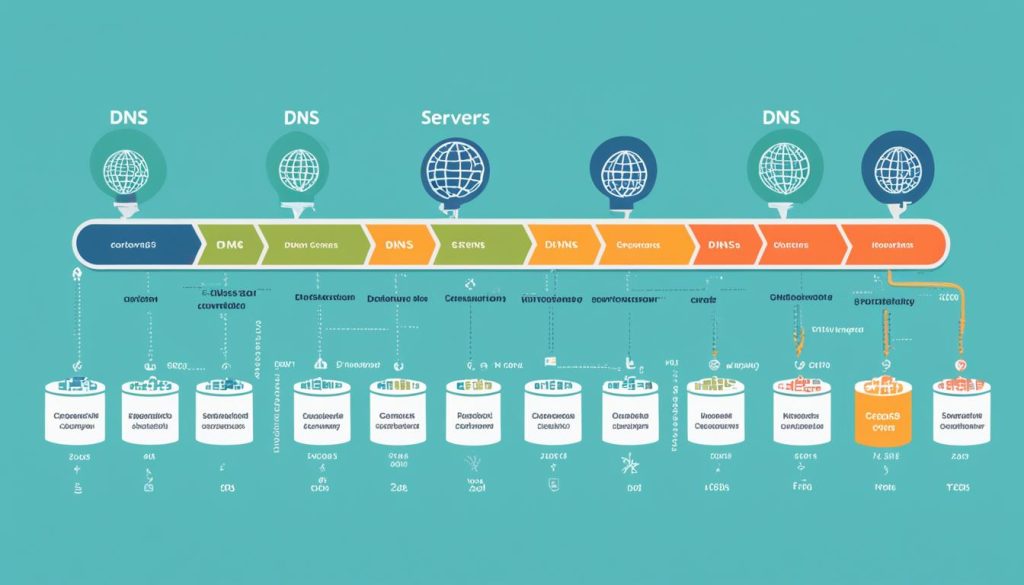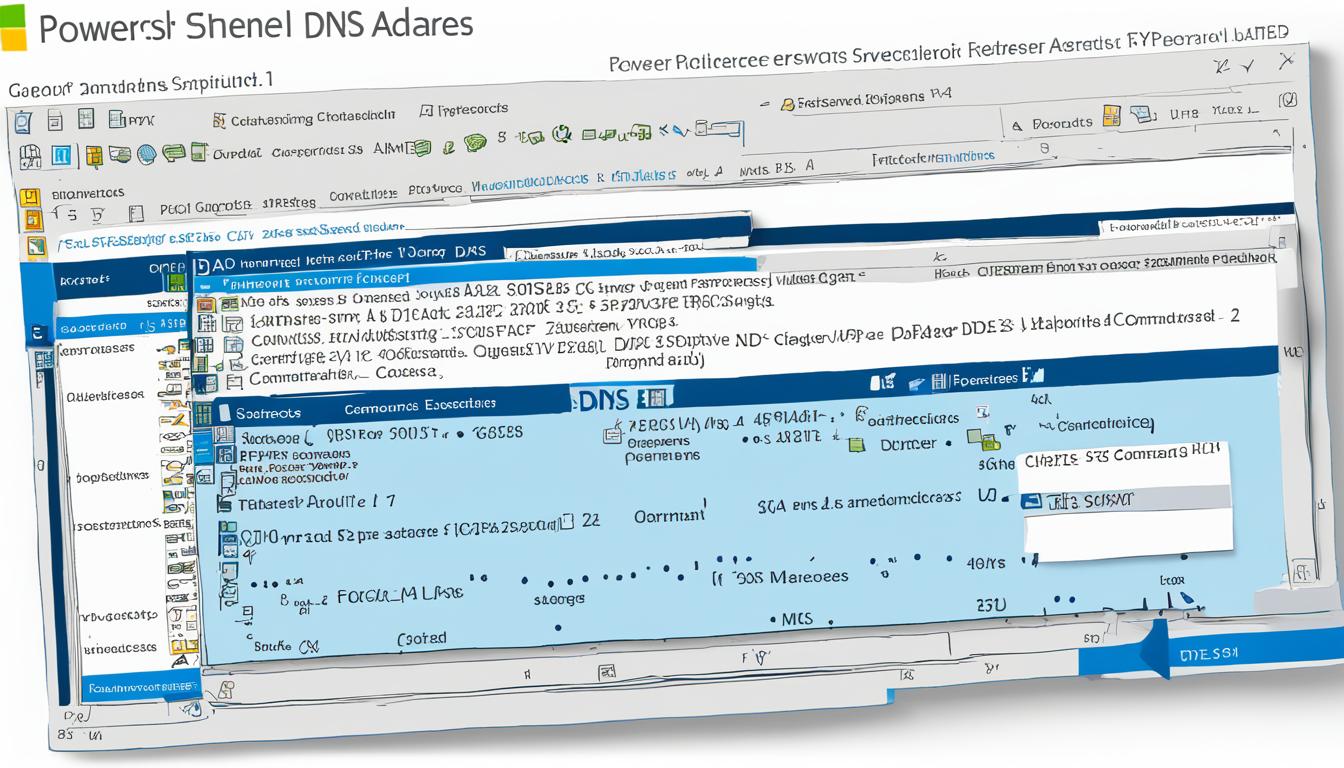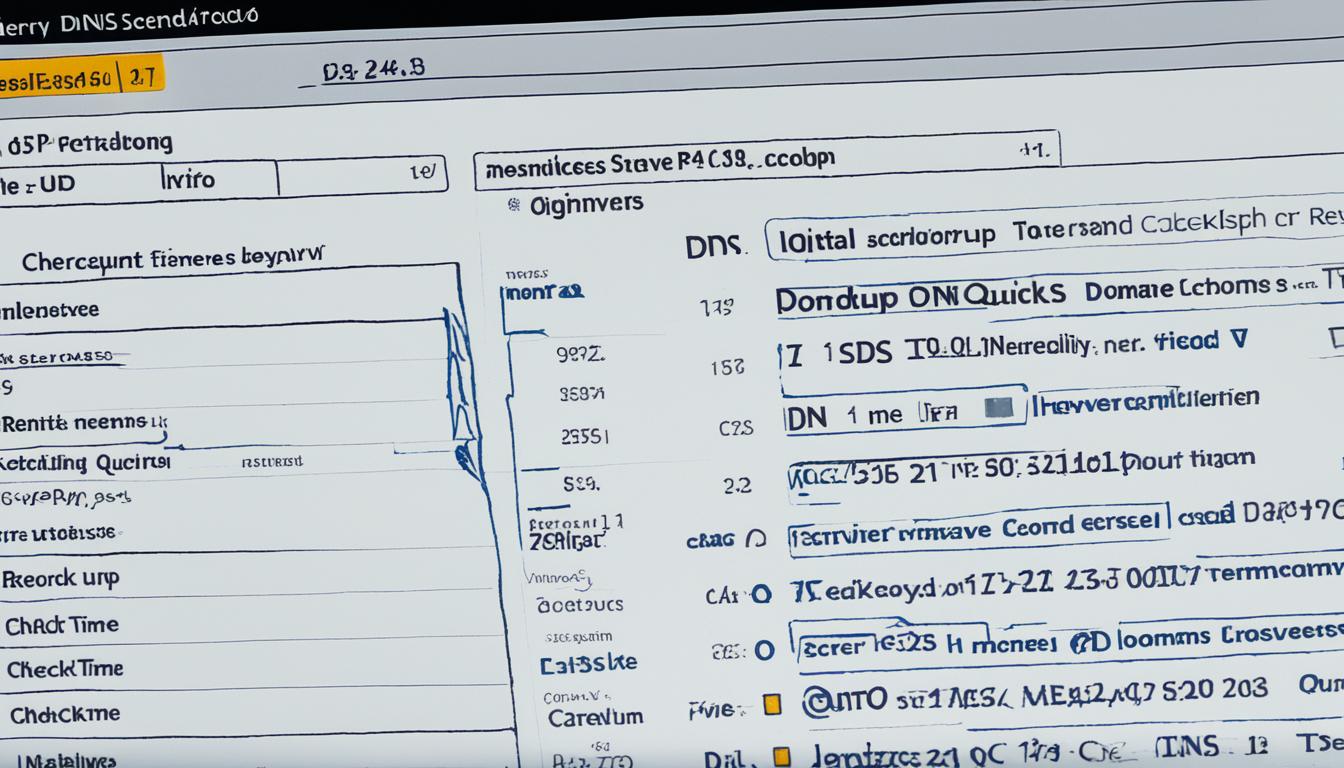About DNS (RFC 1034 – RFC 1035)
Did you know that the Domain Name System (DNS) handles an astonishing amount of internet traffic every day? With billions of queries being processed worldwide, DNS plays a vital role in turning domain names into functional IP addresses that allow users to access websites, send emails, and more. In this article, we will explore the concepts, facilities, and protocols defined in RFC 1034 and RFC 1035, which form the foundation of DNS. Get ready to dive into the world of DNS and uncover its inner workings, from DNS queries and resolution to the role of DNS servers and the importance of DNS security.
Key Takeaways:
- The Domain Name System (DNS) is a vital component of the internet infrastructure.
- DNS is responsible for translating domain names into IP addresses.
- DNS queries and responses are the basic communication mechanism of DNS.
- DNS servers play a crucial role in resolving queries and providing the necessary information.
- Resource records, such as A records and NS records, store information in DNS databases.
Overview of DNS
The Domain Name System (DNS) is a fundamental technology that powers the internet. It serves as a distributed naming system, allowing the assignment of unique domain names to resources on the web. DNS provides a hierarchical structure for organizing and managing domain names, enabling users to easily access websites, send emails, and utilize various internet services.
The primary function of DNS is to translate user-friendly domain names, such as www.example.com, into the IP addresses used by computers to identify and communicate with each other. This translation, known as DNS resolution, is carried out through the use of queries and responses.
DNS servers play a central role in the DNS ecosystem, resolving queries by providing the appropriate IP addresses or other data requested by clients. These servers, which can be authoritative name servers or recursive resolvers, work together to ensure efficient and reliable name resolution.
The DNS protocol specifies the format and rules for communication between DNS clients and servers. It supports various types of resource records, such as A records for IP addresses, MX records for mail server addresses, and TXT records for text descriptions. These records store the essential information associated with domain names.
Additionally, DNS incorporates caching mechanisms to improve the speed and efficiency of name resolution. Caches store previously resolved queries in memory, allowing for faster retrieval of information and reducing the load on DNS servers.
Overall, DNS is a critical component of the internet infrastructure, enabling seamless communication and access to internet resources. Its hierarchical structure, query-based operation, and various facilities make DNS an essential technology for the smooth functioning of the online world.
History of DNS
Before the development of the Domain Name System (DNS), managing host name to address mappings on the internet was a daunting task. A single file called HOSTS.TXT, centrally managed by the Network Information Center (NIC), contained all the mappings. However, as the internet grew rapidly, this centralized approach became inefficient and posed scalability issues.
With the evolution of the internet, the network population shifted from timeshared hosts to local networks of workstations, demanding more advanced name services. In response, the domain system, or DNS, was introduced to address these challenges and provide a scalable and efficient solution.
The key innovation of DNS was the introduction of a hierarchical name space and distributed database for managing domain names and their associated information. This design was based on proposals for hierarchical name spaces and distributed databases, and it aimed to revolutionize the way host name to address mappings were handled.
The development of DNS involved multiple iterations and refinements, ultimately leading to the system specified in RFC 1034 and RFC 1035. These documents form the basis of modern DNS implementations and provide a framework for managing domain names and facilitating efficient communication on the internet.

DNS Design Goals
When designing the Domain Name System (DNS), several goals and requirements come into play, shaping its structure and functionality. The DNS aims to provide a consistent name space, a distributed database, the parallel use of different formats, and support for a wide spectrum of host capabilities.
Consistent Name Space
The primary goal of the DNS is to establish a consistent name space that enables users to refer to resources on the internet. By utilizing a hierarchical structure, the DNS ensures that domain names are unique and can be translated into their corresponding IP addresses or other relevant data.
Distributed Database
The DNS adopts a distributed database architecture, wherein different name servers store and manage subsets of the overall domain name space. This approach not only improves scalability but also allows for efficient management of the vast amount of data associated with domain names and their associated resources.
Parallel Use of Different Formats
The DNS supports the parallel use of various data formats, accommodating different address formats for different protocols. This flexibility ensures that the DNS can be utilized across diverse networks and applications without restrictions, offering compatibility and seamless integration.
Wide Spectrum of Host Capabilities
The design of the DNS caters to a wide spectrum of host capabilities, ranging from personal computers to larger timeshared hosts. This adaptability allows for the accessibility and utilization of the DNS by a diverse range of devices and systems, ensuring inclusivity and compatibility.
Overall, the design of the DNS strives to provide a robust and versatile naming system that fulfills the needs of the internet community. By achieving consistent name space, employing a distributed database, supporting different data formats, and accommodating various host capabilities, the DNS effectively supports internet applications and services.
Assumptions about DNS Usage
When it comes to the Domain Name System (DNS), certain assumptions shape its design and functionality to meet the needs of its user community. These assumptions consider the size of the total database, the frequency of updates, the distributed responsibility, the importance of trusted name servers, and the access to information.
Size of the total database
The DNS assumes that the size of the total database will initially be proportional to the number of hosts using the system. However, as the number of users and the amount of data associated with them grow, the size of the database will also increase.
Frequency of updates
While most of the data in the DNS changes slowly, such as mailbox bindings and host addresses, the system is designed to handle subsets of data that change more rapidly. This ensures that updates can be processed efficiently and effectively.
Distributed responsibility
Administrative responsibility for the DNS database is assumed to be distributed among different organizations. Each organization is responsible for managing specific domains and providing redundant name servers. This distributed responsibility enhances the reliability and availability of the DNS infrastructure.
Trusted name servers
Clients of the DNS should have the ability to identify and prefer trusted name servers. This ensures that they can rely on authoritative sources for accurate and secure DNS information. Trusted name servers enhance the overall reliability and security of the DNS.
Importance of access to information
Access to information is considered more critical than instantaneous updates or guarantees of consistency in the DNS. To facilitate efficient access, the DNS allows for the distribution of copies of the database with timeouts for refreshing. This ensures that users can access the information they need in a timely manner.
Iterative and recursive query handling
DNS implementations should support both iterative and recursive approaches to handling queries. The iterative approach is preferred for the datagram-style access commonly used in DNS. This flexibility in query handling allows for efficient and versatile interactions with the DNS infrastructure.
| Assumption | Description |
|---|---|
| Size of the total database | Proportional to the number of hosts initially, growing with the number of users and associated data. |
| Frequency of updates | Most data changes slowly, while subsets of data change more rapidly. |
| Distributed responsibility | Administrative responsibility is distributed among organizations managing specific domains and providing redundant name servers. |
| Trusted name servers | Clients can identify trusted name servers to enhance reliability and security. |
| Access to information | More important than instantaneous updates or consistency guarantees, the DNS allows for distribution with timeouts for refreshing. |
| Iterative and recursive query handling | DNS implementations support both iterative and recursive approaches, with preference given to the iterative approach for datagram-style access. |
DNS Messages and Format
In the Domain Name System (DNS), communication between DNS clients (resolvers) and DNS servers takes place through the exchange of messages. These messages follow a specific format, as specified in RFC 1035, which outlines the structure and content of the various sections within a DNS message.
Header Section
The header section of a DNS message contains essential information about the message itself. This includes the ID, which helps match responses to their corresponding queries, as well as flags indicating various aspects of the message, such as whether it is a query or a response. The header section also includes counts for the number of questions, answers, authority records, and additional records present in the message.
Question Section
The question section of a DNS message provides details about the query being sent by the resolver. This includes the domain name being queried and the type of query being made, such as an A record query for retrieving the IP address associated with a domain name.
Resource Record Format
In a DNS message, each response is organized as a resource record. Resource records contain various fields, including the record type, which specifies the type of information contained in the record (e.g., A record, NS record, MX record), the class, which indicates the protocol to which the record belongs (e.g., IN for Internet), the TTL (Time to Live), which determines how long the information can be cached, and the actual data associated with the record, such as the IP address or domain name.
Message Compression
DNS messages can make use of message compression, a technique that allows for shorter representations of domain names by referencing previously encountered names within the message. This compression helps reduce the overall size of DNS messages and improves efficiency in transmitting and processing them.
To properly implement and handle DNS communication, it is important to understand the structure and format of DNS messages. By following the specific guidelines outlined in RFC 1035, DNS clients and servers can communicate effectively and efficiently, enabling the successful resolution of domain names into IP addresses and other related information.

DNS Implementation and Configuration
Implementing and configuring the Domain Name System (DNS) requires careful consideration of various components and aspects. The architecture of the name server is a critical element, encompassing control, database management, and time synchronization. Name server implementations must efficiently handle query processing, including resolving recursive and iterative queries, as well as managing zone refresh processes. A vital component of DNS is the resolver, which serves as the interface between user programs and the DNS infrastructure. The resolver transforms user requests into queries, sends them to DNS servers, and processes the responses received. DNS implementations also provide support for essential mail-related functions, including mail exchange binding and mailbox binding.
Configuring DNS involves the setup of authoritative name servers, defining zones, and configuring their associated resource records within master files. It is crucial to establish proper communication and synchronization between primary and secondary servers to ensure data consistency and redundancy. Understanding the different aspects of DNS implementation and configuration is essential for maintaining a reliable and efficient DNS infrastructure.
In summary, DNS implementation and configuration involve various considerations, including name server architecture, query processing, zone management, resolver implementation, and mail support. These elements play vital roles in establishing a robust DNS infrastructure that effectively translates domain names into IP addresses and facilitates seamless communication and access to internet resources.
FAQ
What is the Domain Name System (DNS)?
How does DNS work?
What is the role of DNS servers in name resolution?
What are resource records in DNS?
How is DNS structured?
What is DNS protocol?
How does DNS ensure security?
What is DNS caching?
- How Strategic SEO Drove Growth for a CPAP E-commerce Brand - July 24, 2025
- Top 3 SEO Companies in Toronto: An Analytical Comparison - July 23, 2025
- SEO for Entry Door Services - April 24, 2025





















Post Comment
You must be logged in to post a comment.